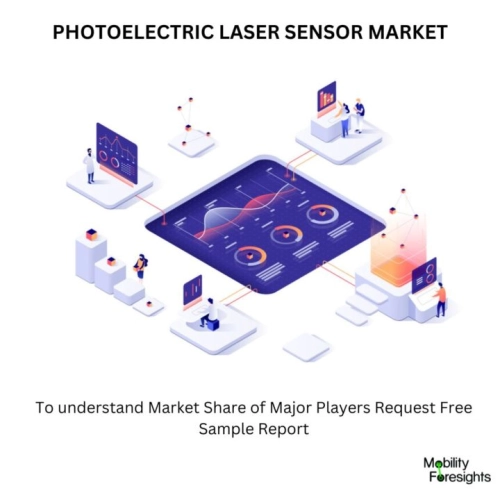
- Get in Touch with Us

Last Updated: Apr 25, 2025 | Study Period:
The Photoelectric Laser Sensors market is growing at a robust rate, with innovations in the field of industrial automation and their applications extending across industry lines. These sensors have an additional impact on operational efficiency and precision during a manufacturing process by ensuring proper distance measurement, and the ability to detect the presence, and recognition of objects. The key industries that make the maximum utilization of photoelectric laser sensors are automotive, electronics, food and beverages, pharmaceuticals, and logisticsâthese sensors are applied in developing production lines, ensuring the quality of products, and performing undisturbed material handling.
Factors that would predominantly aid market growth include technological advancement via miniaturization, enhanced industrial connectivity by means of IO-Link and Industry 4.0 integration, and improved sensor functions, including longer detection ranges and higher reliability. Manufacturers are thereby manufacturing compact, robust, and versatile sensors to meet the application requirements in today's industrial environments. Moreover, the competitive landscape of the market is characterized by a few key participants who constantly innovate in offering the most advanced solutions on sensors for specific industrial uses, thereby fueling the market more.
The photoelectric laser sensor is a type of sensor that uses a laser beam to detect the presence of objects or materials. It works by projecting a beam of light across a field of view and measuring the intensity of the reflected light. If an object or material is present, then the reflected light will be different from the light that was projected, and the sensor can detect this difference.
The photoelectric laser sensor is commonly used in industrial settings, such as in manufacturing and robotics. It can detect objects in a range of sizes, and is highly accurate, allowing it to detect even very small objects or materials. Additionally, it can be used to measure distances or the speed of objects, making it an ideal choice for many applications.
The photoelectric laser sensor is highly versatile, and it can be used in a variety of ways. For example, it can be used to detect the presence of an object, or to measure its distance from the sensor. It can also be used to detect the speed of an object, or to measure the size and shape of an object. Additionally, it can be used to detect changes in temperature or in the presence of liquids.
In addition to its versatility, the photoelectric laser sensor is also highly reliable. It is very accurate, and its readings can be trusted with confidence. Additionally, it is relatively easy to install, making it a great choice for many applications.
Overall, the photoelectric laser sensor is a highly versatile and reliable type of sensor, which makes it an ideal choice for many industrial and robotic applications. Its ability to detect objects, measure distances and speeds, and detect changes in temperature or liquids makes it a great choice for many applications.

The Global photoelectric laser sensor market accounted for $XX Billion in 2023 and is anticipated to reach $XX Billion by 2030, registering a CAGR of XX% from 2024 to 2030.
Laser triangulation and similar technologies improve the accuracy and reliability of detection. It improves the ability of sensors to detect a wide range of materials, and highly reflective and transparent surfaces, and expands the range capability to meet various distance requirements.
The algorithms embedded within the sensors enable adaptive functionality, such as auto-adjustment to surroundings and object recognition. Therefore, this trend toward smart sensors enhances reliability, reduces false positives, and thus improves overall system performance.
Growing is the demand for devices with robust designs to stand up in harsh industrial surroundings: IP67/69K ratings, strong housings, resistant against vibration, and shock ensure that sensors' performance won't be influenced by contrary conditions.
R20x
Pepperl+Fuchs launched a new line of medium-sized photoelectric sensors, the R20x series. This series integrated innovative features such as DuraBeam laser technology and Multi Pixel Technology to increase accuracy and reliability. DuraBeam laser technology combines the resilience and huge temperature range of LED emitters with the extended reach and beam intensity of laser diodes, thereby delivering energy efficiency and durability under extreme conditions. The Multi Pixel Technology also utilized geometric triangulation for highly accurate measurement of distance and detection of any objects; this was made possible through intelligent software algorithms. The range of sensors also incorporated rotatable connectors for space-constrained applications and IO-Link standardized connections for comfortable integration and easier maintenance across all industrial applications.
Machine Vision Photoelectric Sensors
Hikrobot has introduced its Machine Vision Photoelectric Sensors, developed for various applications in distance detection, into the Indian market. These were designed to extend to a broad range of applications across different industry verticals. The technology used behind these sensors includes the transmission of visible and infrared light by means of a transmitter, and it detects any changes in light reflection or obstruction by any object with the help of a receiver to generate an output signal. This non-contact type of detection ensures long life and low maintenance by preventing damage to both the sensor and detected objects. Moreover, the sensors are stable in noisy environments and high-frequency electromagnetic fields, which allows for reliable detection over long distances. Highlights of the Sensors The photoelectric sensors use IP67 protection against sunlight, LED light interference, or electromagnetic interference but feature small point and laser technology for precise detection at extended distances that will detect a wide array of materials and situations
SICK W10
SICK introduced the innovative W10 by SICKâthe world's first photoelectric sensor with a touchscreen display, setting a new standard in universal and user-friendly sensing technology. The ease of use of this innovative sensor is further increased by a swiping-up touchscreen interface with intuitive icons for swift adjustments and parameter settings. Due to the fact that it is designed for versatilityâthat is, used in various industrial automation applicationsâthe SICK W10 simplifies installation and offers predefined setting options for common sensor functions such as background and foreground suppression within one device. In this respect, the housing of the Sick W10 has been realized in stable stainless steel with IP69K protection for maximum resistance against environmental influences in factory and logistics automation. This product ensures safe operation with Class One visible red laser technology and provides intelligent algorithms that enable high repeatability and reliability in a variety of applications. Also, it is flexible because of its standard, high-speed, and precision modes; therefore, it is suitable for different detection tasks, such as level detection in bowl feeders and presence detection on irregularly shaped components or those with reflective surfaces.
By Geography
By Type Of Sensor Technology
By Application
By Type
| Sr.N | Topic |
| 1 | Market Segmentation |
| 2 | Scope of the report |
| 3 | Research Methodology |
| 4 | Executive Summary |
| 5 | Average B2B by price |
| 6 | Introduction |
| 7 | Insights from Industry stakeholders |
| 8 | Key Drivers for Photoelectric Laser Sensors market |
| 9 | Disruptive Innovation in the Industry |
| 10 | Overview of Photoelectric Laser Sensors market |
| 11 | Major impact on Technological advancements |
| 12 | Consumer trends in the industry |
| 13 | Recent technological trends in Photoelectric Laser Sensors market |
| 14 | SWOT Analysis of Key Market Players |
| 15 | New product development in the past 12 months |
| 16 | Market Size, Dynamics, and Forecast by Geography , 2024-2030 |
| 17 | Market Size, Dynamics, and Forecast by Type of Sensor Technology , 2024-2030 |
| 18 | Market Size, Dynamics, and Forecast by Application, 2024-2030 |
| 19 | Market Size, Dynamics, and Forecast by Type, 2024-2030 |
| 20 | Competitive landscape |
| 21 | Gross margin and average profitability of suppliers |
| 22 | Merger and Acquisition in the past 12 months |
| 23 | Growth strategy of leading players |
| 24 | Market share of vendors, 2023 |
| 25 | Market Company Profiles |
| 26 | Unmet needs and opportunities for new suppliers |
| 27 | Conclusion |